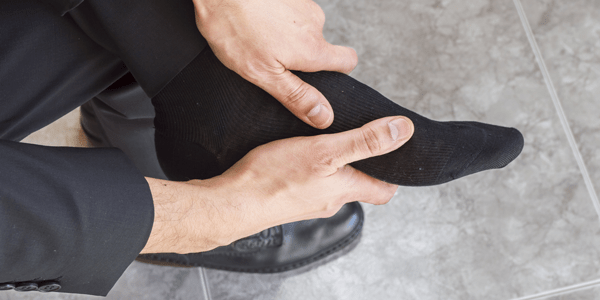
Plantar fasciitis can be a painful injury, and figuring out a cause and solution for it can be frustrating. Some people may respond to stretches, and others to custom orthotics – but in many cases, it’s best to use a combination of the treatments below for an effective recovery.
When at rest, your feet naturally want to plantar flex (point downward). This position shortens the plantar fascia tissues underneath your feet while they’re recovering from the day of use, which results in painful micro-tears when you put weight on your feet again.
To prevent this, night splints are worn to hold the ankle at 90 degrees during rest. By stretching the tissues while resting, they can heal in a position closer to their active state.
If you experience pain in your feet each morning, that is one of the best indications that night splints will work for you.
Custom Orthotics
If your foot overpronates – meaning that it excessively rolls down and inward when you stand or walk – it can cause extra tension on the fascial tissue. Orthotics or insoles can reduce this motion by supporting your arch, which can help reduce the strain to the plantar fascia.
Alternatively, if you have a high rigid arch, the plantar fascia will be very tight and inflexible. You will also experience increased impact at your heel, near the origin of the fascia. An orthotic will distribute pressure along the bottom of your foot, reducing impact directly at the heel and reducing strain on the plantar fascia.
Walking Mobility Clinic’s Canadian-certified pedorthists are experts in gait assessment and orthotic design.
Supportive Footwear
If you have a flexible foot, a structured shoe with torsional stability and a heel counter can help reduce some tension to the plantar fascia. However, if you have a rigid foot, a shoe with good shock absorption can help lessen impact forces to the heel.
One of the functions of the plantar fascia is to propel the foot during toe-off. A stiff front rocker can aid in this motion while reducing strain and lessening the workload on the plantar fascia.
It’s also worth noting, When people experience foot pain, they usually look at their work and casual footwear, but not what they wear around the house. Unfortunately, many people don’t realize how much time they spend on their feet at home. When you add hardwood floors into the equation, this can put a lot of strain on your feet.
Consistent support is a key factor to healing plantar fasciitis, and a pair of slippers or sandals with built-in arch support is a great option – they are easy to slide on and will always be by the bed.
Rolling Devices
Massaging the plantar fascia with a rolling device is a simple treatment option that can be used easily at home. It can help stretch out the plantar fascia, improve blood flow to the area, promote healing, and relieve pain.
Use a massage ball 2 – 3 times a day for 2-minute intervals to massage the bottom of your feet.
Talk to an Expert
It is always best to check with a medical practitioner or foot care specialist; they can help guide you towards different treatment options.
Pedorthists at Walking Mobility Clinic can answer your questions and help you recover. Find a location near you today!
